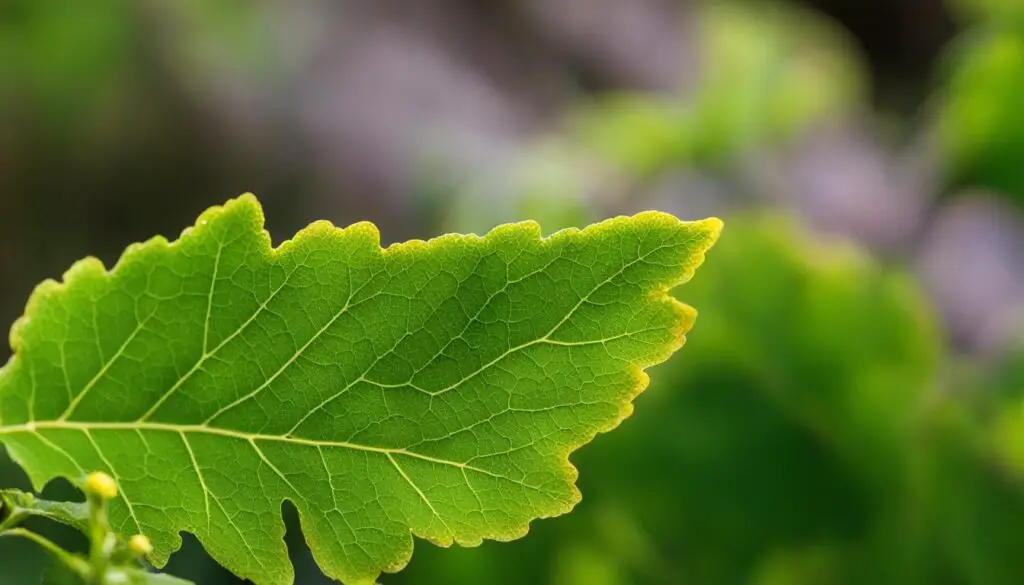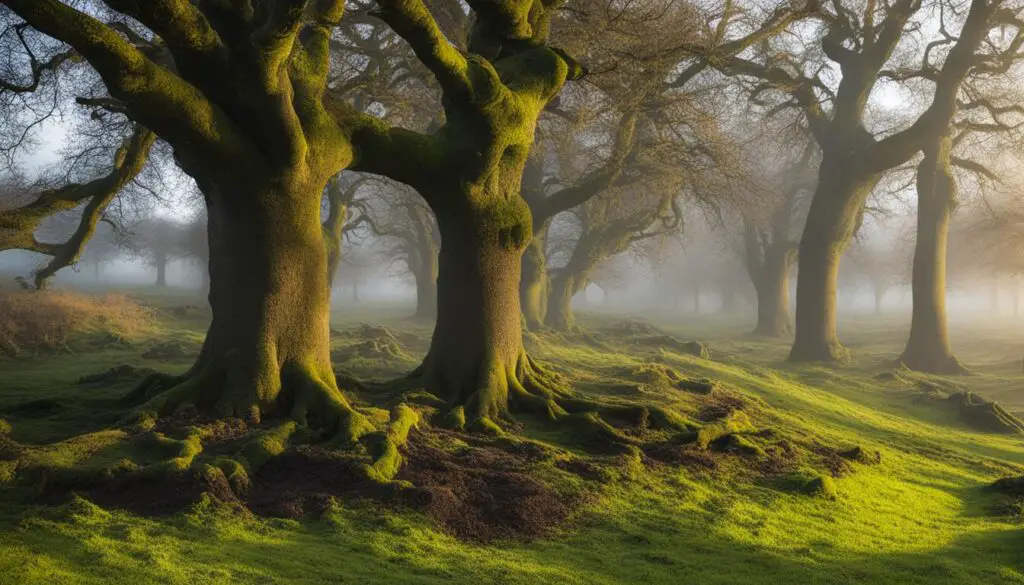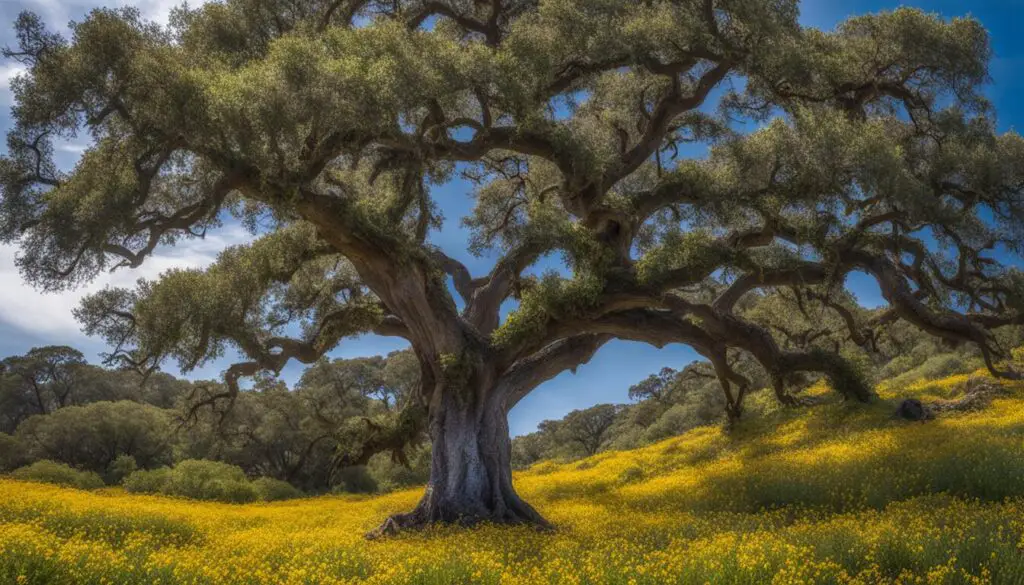Oak trees are renowned for their majestic beauty and sturdy presence in landscapes across the world. From their towering height to their sprawling branches, oak trees have captivated human fascination for centuries. One particularly enchanting aspect of oak trees is their blooming season, when they showcase their delicate flowers and vibrant foliage.
So, when do oak trees bloom? The blooming season of oak trees depends on various factors such as climate, species, and geographical location. However, in general, oak trees bloom in the spring, typically between March and May. This is a time of rejuvenation and growth for many trees and plants.
During the blooming season, oak trees produce both male and female flowers. The male flowers, known as catkins, are clustered structures that release pollen into the air before falling from the tree. On the other hand, the female flowers are less visible and develop into acorns, which are the iconic fruit of oak trees.
Key Takeaways:
- The blooming season of oak trees is typically in the spring, between March and May.
- Oak trees produce male flowers in the form of catkins and female flowers that develop into acorns.
- Oak trees take decades to mature and can live for up to 1,000 years.
- Mast years, characterized by high acorn production, occur every 2-5 years.
- Oak trees provide habitats and food sources for various species of wildlife.
The Blooming Process of Oak Trees
Oak trees have a fascinating blooming process that contributes to their beauty and ecological importance. During springtime, oak trees produce both male and female flowers, each with its own unique development and purpose.
The male flowers of oak trees are organized in structures called catkins. These elongated clusters consist of small, inconspicuous flowers that release pollen into the air. The catkins sway in the breeze, facilitating the dispersal of pollen to female flowers on the same tree or nearby oak trees. This pollination process is essential for successful reproduction and acorn production.
The female flowers of oak trees develop in small cones or structures known as cupules. These flowers are less visible compared to the showy catkins, but they play a vital role in the tree’s reproductive cycle. Once pollinated, the female flowers transform into acorns, which serve as the seeds of the oak tree. Over time, the acorns mature and drop from the tree, allowing for the regeneration and propagation of new oak trees.
The blooming process of oak trees occurs in a cyclical pattern, with variations in the amount of flowers and acorns produced from year to year. This phenomenon, known as boom and bust cycles, is influenced by environmental factors such as weather conditions and nutrient availability. In mast years, oak trees experience an abundance of acorn production, while in lean years, the production is significantly lower.
Acorns produced by oak trees play a crucial role in supporting wildlife populations. They serve as a valuable food source for various animals, including birds, squirrels, and deer. Acorns provide essential nutrients and energy, ensuring the survival and well-being of many species.
Overall, the blooming process of oak trees is a complex and intricate phenomenon, involving the development of catkins, the pollination of female flowers, and the subsequent production of acorns. This process is not only visually captivating but also contributes to the sustainability of ecosystems and the survival of numerous wildlife species.
Identifying Oak Trees and Their Blooms
If you’re interested in oak trees, it’s essential to know how to identify them. By examining their leaves, flowers, and bark, you can easily distinguish different types of oak trees.
Leaf Identification
Oak trees have distinct foliage characteristics that can help with identification. The English oak, also known as Quercus robur, has green leaves with deep lobes and barely any leaf stalk. In contrast, the sessile oak, or Quercus petraea, has leaves with stalks and is hairier, with less deeply lobed leaves.

Oak Tree Flowers
Oak trees produce flowers in the spring, with two types of flowers: male catkins and female flowers. The male catkins are slender and can be easily spotted hanging from the branches. On the other hand, the female flowers are inconspicuous and often overlooked. They play a crucial role in producing acorns, the tree’s reproductive structures.
Bark Characteristics
The bark of oak trees is another distinguishing feature. It is typically dark grey-brown and develops vertical fissures as the tree matures. The combination of its color and texture adds to the oak tree’s majestic appearance.
Foliage Changes
As deciduous trees, oak trees undergo changes in their foliage throughout the year. In autumn, the leaves turn yellowy brown before eventually falling off. This seasonal transformation is a beautiful sight to behold and can also assist with oak tree identification.
By observing the distinct leaf shapes, identifying the different types of flowers, and examining the unique bark characteristics, you can confidently identify oak trees and appreciate their natural beauty.
Oak Trees and Their Importance in the UK
The UK is home to two native species of oak: English oak and sessile oak. These majestic trees play a vital role in supporting biodiversity, providing essential habitats for a wide range of birds, insects, and mammals. The native oak species in the UK support over 2,300 associated species, with more than 300 solely reliant on oak trees for their survival.
Oak trees create thriving ecosystems, fostering a diverse community of flora and fauna. They offer shelter, food, and nesting sites for various bird species, including woodpeckers, nuthatches, and owls. The acorns produced by oak trees are a valuable food source for small mammals like squirrels, mice, and deer. Additionally, oak trees support a rich population of invertebrates, such as butterflies, beetles, and bees.
However, oak trees in the UK face significant threats that endanger their survival. Two notable challenges are the oak processionary moth and acute oak decline. The oak processionary moth, an invasive species, poses a risk to the health of oak trees and human health due to its toxic caterpillar hairs. Acute oak decline is a complex disease that causes the rapid decline of oak trees, leading to their eventual death.

Lifespan and Size of Oak Trees
Oak trees are some of the longest-lived trees in the UK, with a potential lifespan of over 1,000 years. These wise giants reach maturity at around 40 years old, becoming majestic trees that can grow to be 20-40m in height, with a spread of 20m or more. Their towering presence adds grandeur to any landscape.
The Journey to Greatness
As oak trees grow and mature, they undergo different stages, each marking a milestone in their lifespan. Mature oaks are classified as veteran trees when they reach 150-300 years old, reflecting their remarkable resilience and enduring character. Once ancient oaks pass the 400-year mark, they become true testaments to the passage of time, capturing our imagination and connection to history.
Understanding the growth patterns and longevity of oak trees is essential for appreciating their significance and impact on the natural world. These extraordinary trees encapsulate the concept of strength and longevity, standing as sentinels of time in our forests.
Famous Oak Tree Contest
The debate over the UK’s oldest oak trees ignites curiosity and sparks friendly competition among nature enthusiasts. While many contenders vie for the title, a few remarkable oaks stand out:
- The Marton Oak: This mighty oak, located in Cheshire, is believed to be one of the oldest in the country, estimated to be over 1,000 years old.
- The Big Belly Oak: Nestled in Savernake Forest, Wiltshire, this ancient oak’s girth measures a staggering 42 feet, captivating visitors and inspiring awe.
- The Bowthorpe Oak: Situated in Bourne, Lincolnshire, this iconic oak boasts a hollow trunk large enough to accommodate several adults, making it a popular destination for exploring.
- The Major Oak: Located in Sherwood Forest, Nottinghamshire, this legendary oak is associated with the tales of Robin Hood and his Merry Men, captivating the imagination of many.
These notable contenders symbolize the lasting legacy of oak trees, reminding us of the incredible lifespans and enduring beauty that stands the test of time.
Value of Oak Trees to Wildlife
Oak trees are essential contributors to the ecosystem, providing valuable habitats and food sources for a wide range of wildlife. They play a crucial role in supporting biodiversity and fostering a healthy environment.
One of the key contributions of oak trees to wildlife is through the production of acorns. These nuts serve as an important food source for various animals, including birds, small mammals, and deer. The high nutritional value of acorns makes them a vital part of the diet for many wildlife species.
In addition to the nutritional benefits, oak trees also provide shelter and nesting sites for numerous invertebrates, such as caterpillars, moths, and gall wasps. These insects rely on oak trees for both food and habitation. In turn, they become an essential food source for other wildlife, including birds and bats.
Furthermore, oak woods are known to have the highest biodiversity among native woodlands in the UK. They support a diverse range of flora and fauna, creating a rich and vibrant ecosystem. Many species of birds, mammals, insects, and plants thrive in the presence of oak trees, demonstrating their importance as habitats.
Oak trees also contribute to a healthy environment by absorbing carbon dioxide and releasing oxygen through the process of photosynthesis. They play a role in mitigating climate change and improving air quality.
In summary, oak trees are invaluable to wildlife, serving as habitats, food sources, and providers of essential ecosystem services. Preserving and protecting oak tree populations is crucial for maintaining biodiversity and sustaining the delicate balance of our natural world.
Growing and Caring for Oak Trees
If you have a large garden or space for hedges, growing oak trees can be a rewarding experience. Oak trees bring beauty, shade, and wildlife to your outdoor space. To ensure their healthy growth and longevity, follow these tips for planting and caring for oak trees.
Choosing the Right Location and Soil
Oak trees prefer well-drained soil and thrive in full sun or partial shade. They can be grown in most moist but well-drained soils, including sandy and clay soils. Before planting, assess your garden’s conditions to ensure they are suitable for oak tree growth.
Planting Oak Trees
Oak trees should be planted during their dormant period, which is usually in winter. The dormant period allows the tree to establish its roots before the growing season begins. When planting bare-root saplings, it’s crucial to soak them in water for several hours before planting to prevent dehydration.

Growing from Acorns
If you prefer starting from scratch, you can grow oak trees from acorns. Collect mature acorns in autumn and plant them in individual pots filled with well-drained soil. Transplant the seedlings into larger containers or directly into the ground after their first true leaves mature.
Minimal Pruning and Maintenance
Oak trees require minimal pruning once established. Prune only dead, damaged, or crossed branches to maintain the tree’s structure and health. Avoid excessive pruning, as it can stress the tree. Regularly monitor the soil moisture levels and provide additional watering during dry periods to ensure your oak tree stays healthy.
By following these guidelines, you can ensure the successful growth and care of your oak trees, creating a beautiful and inviting outdoor space.
The Coastal Live Oak Species and Uses
The coastal live oak is an evergreen tree that can reach heights of 10-25m. It boasts a dense crown and widely spreading branches, creating a picturesque and majestic appearance. This oak species is particularly valuable for its ability to stabilize soil on slopes, preventing erosion and promoting environmental conservation.
Moreover, the coastal live oak plays a vital role in supporting diverse wildlife populations. Its branches and foliage offer essential habitats for insects, birds, and mammals, enabling a variety of species to thrive. Additionally, the acorns produced by coastal live oaks serve as a crucial food source for wildlife.
In the past, Native Americans recognized the nutritional significance of acorns and utilized them as a staple food. Furthermore, the wood from coastal live oaks held various industrial uses, including charcoal production and other applications.

| Coastal Live Oak Species Characteristics | Uses |
|---|---|
| An evergreen tree Height: 10-25m Dense crown Widely spreading branches |
Stabilizes soil on slopes Provides habitats for insects, birds, and mammals Produces acorns as food source |
Conclusion
Oak trees are truly remarkable beings, embodying strength and beauty in every aspect. From their captivating blooming process, featuring the majestic display of catkins and acorns in the vibrant spring season, to their vital role as guardians of ecosystems, oak trees leave an indelible mark on the natural world.
As stewards of biodiversity, oak trees provide critical habitats and essential food sources for a diverse range of wildlife. They support a harmonious balance, nurturing countless species and contributing to the intricate tapestry of life. The longevity of oak trees, which can span centuries, further enhances their significance as iconic features of both natural landscapes and man-made environments.
Whether marveling at the enchanting blooming process or appreciating the enduring endurance of oak trees, their presence never fails to instill a sense of awe and inspiration. Let us cherish and protect these magnificent giants, ensuring that future generations can also experience the profound beauty and ecological value they offer.
FAQ
When do oak trees bloom?
Oak trees bloom in spring.
What is the blooming season for oak trees?
The blooming season for oak trees is in spring.
When do oak trees produce flowers?
Oak trees produce flowers in spring.
How long does the oak tree blooming period last?
The oak tree blooming period typically lasts throughout the spring season.
Do oak trees have male and female flowers?
Yes, oak trees are monoecious and have both male and female flowers on the same branch.
What are the male flowers of oak trees called?
The male flowers of oak trees are formed in catkins.
What do the female flowers of oak trees develop into?
The female flowers of oak trees will eventually develop into acorns.
Are oak trees known for their acorn production?
Yes, oak trees have boom and bust cycles of acorn production, with mast years occurring every 2-5 years.
How long does it take for an oak tree to mature?
Oak trees take decades to mature.
What is the average lifespan of an oak tree?
Oak trees can live up to 1,000 years.
How can oak trees be identified?
Oak trees can be identified by their leaves and acorns.
What are the native oak species in the UK?
The native oak species in the UK are the English oak and the sessile oak.
Why are oak trees important in the UK?
Oak trees in the UK are important for their biodiversity support and provide habitats for various species of birds, insects, and mammals.
What threats do oak trees in the UK face?
Oak trees in the UK face threats such as oak processionary moth and acute oak decline.
How tall can oak trees grow?
Oak trees can grow to be 20-40m in height.
What is the spread of oak trees?
Oak trees have a spread of 20m or more.
What role do oak trees play in supporting ecosystems?
Oak trees play a crucial role in supporting ecosystems by providing habitats for a diverse range of wildlife and contributing to healthy environments.
Can oak trees be grown in UK gardens?
Yes, oak trees can be grown in UK gardens, but they are best suited for large spaces or as hedges.
What conditions do oak trees prefer for growth?
Oak trees prefer well-drained soil, full sun or partial shade, and can be grown in most moist but well-drained soils.
When is the best time to plant oak trees?
Oak trees should be planted during the dormant period in winter.
How can oak trees be cared for?
Oak trees require minimal pruning and maintenance once established.
What is the coastal live oak species?
The coastal live oak is an evergreen tree that can reach heights of 10-25m.
What is the significance of the coastal live oak?
The coastal live oak stabilizes soil on slopes and provides habitats for insects, birds, and mammals.
What is the lifespan of oak trees?
Oak trees can live for centuries, with some reaching over 1,000 years in age.
Why are oak trees valued as a symbol of strength and beauty?
Oak trees are valued as a symbol of strength and beauty due to their unique blooming process, long lifespan, and contributions to ecosystems.

